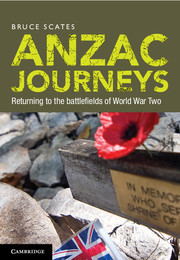Book contents
7 - A post-war dream: Greece and Crete
from PART 2 - DESERT AND ISLAND
Published online by Cambridge University Press: 05 June 2013
Summary
In March 1941 British, Australian and New Zealand forces were diverted from North Africa to Greece to defend the country from German and Italian invasion. The German army overran the British, Greek and Anzac forces but not before both sides suffered heavy losses along the Thermopylae Line and the Aliakmon Line further north. More than 50 000 Allied troops were evacuated from mainland Greece, many of them to Crete. The commander of the New Zealand Division, Major-General Bernard Freyberg, was ordered to defend the island and did so without air support. German paratroopers dropped onto the island in May 1941, targeting the airfields at Maleme, Retimo and Heraklion. After a week of fierce fighting, Australian commanders ordered their men to surrender or attempt to escape. In the defence of Crete, 1742 British Commonwealth troops died and a further 11 000 were taken prisoner.
In April 1951, some ten years after the invasion of Greece, Australian Prime Minister Robert Menzies wrote a letter to Field Marshal Alex Papagos, Generalissimo of the Greek Armed Forces. ‘The Australian government’, Menzies declared, ‘is deeply appreciative of the great honour which is being paid to our country.’ The erection in Athens of a memorial to commemorate ‘Australian and other British Commonwealth troops who were killed during the Nazi invasion of Greece’ was described as a magnificent gesture, a sculpture of Athena, bearing shield and sword, fusing the valour of the classical world with a modern struggle for democracy.
- Type
- Chapter
- Information
- Anzac JourneysReturning to the Battlefields of World War Two, pp. 148 - 173Publisher: Cambridge University PressPrint publication year: 2013



